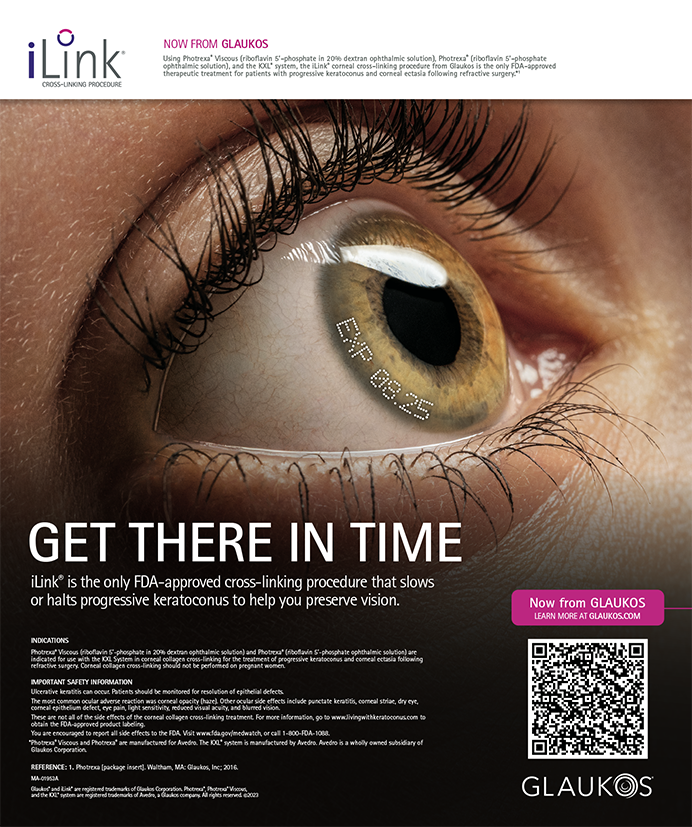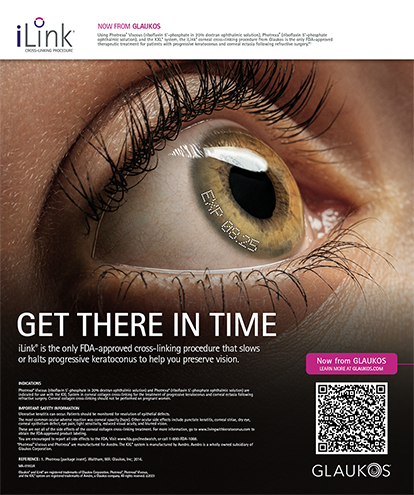Ophthalmic surgical patients' expectations of multifocal IOLs are high, because they have been promised little-to-no dependence on spectacles or contact lenses postoperatively. Attaining this goal requires eliminating astigmatism and achieving a precise postoperative plano refraction within ±0.25 D. This article describes techniques for determining the proper IOL power for multifocal IOLs.
The accuracy of predicting the necessary power for an IOL is directly related to the accuracy of several measurements.1,2 They include central corneal refractive power (keratometry readings), axial length (biometry), horizontal corneal diameter (horizontal white-to-white), anterior chamber depth, lenticular thickness, preoperative refraction, and the age of the patient.
UNDERSTANDING EFFECTIVE LENS POSITION
The term effective lens position was recommended to the FDA in 1995 to describe the position of an IOL in the eye (Figure 1), because the term anterior chamber depth is not anatomically accurate for lenses in the posterior chamber and can confuse the clinician.3 Ophthalmologists' ability to predict the effective lens position has evolved in accuracy over the years, due both to advancements in formulas and to the technical skills of surgeons who consistently implant IOLs in the capsular bag. We now know that a 20.00 D IOL that is axially displaced by 0.5 mm from the predicted effective lens position will result in approximately 1.00 D of error in the patient's stabilized postoperative refraction. For piggyback lenses totaling 60.00 D, however, a 0.5-mm axial displacement will cause a 3.00 D refractive surprise; the error is directly proportional to the power of the implanted lens. This direct relationship to the power of the lens is why the problem is much less evident in extremely long eyes, because the power of the implanted IOL is so small to achieve emmetropia after cataract extraction.
The Holladay 2 formula (Holladay Consulting, Inc., Bellaire, TX) provides more predictable results in normal and unusual eyes than other recent formulas due to its application of seven preoperative variables that my colleagues and I found to be useful for significantly improving the prediction of the effective lens position in eyes ranging from 15 to 35 mm (Figure 2). Once these additional measurements become routine for clinicians, I expect that a new flurry of prediction formulas using seven or more variables will emerge, similar to the activity following our two-variable prediction formula in 1988.2 The standard of care will reach a new level of predictive accuracy for extremely unusual eyes, just as it has for normal eyes. Calculations on patients with axial lengths of between 22 and 25 mm with corneal powers of between 42.00 and 46.00 D will do well with current third-generation formulas (the Holladay 1,2 SRK/T,4 and Hoffer Q5). For cases outside this range, the Holladay 2 should be used to ensure accuracy.
PRIMARY CATARACT SURGERY OR REFRACTIVE LENS EXCHANGE
The intraocular power calculations for refractive lens exchange are no different than those for cataract surgery. Refractive lens exchange is usually reserved for patients who are outside the range of other forms of refractive surgery. Consequently, the measurements of axial length, keratometry, and so forth are usually quite different from those in typical cataract surgery patients because of the exceptionally large refractive error and younger age of patients undergoing refractive lens exchange. In most highly myopic eyes, the axial lengths are extremely long (> 26 mm), whereas highly hyperopic eyes have very short axial lengths (< 21 mm).
In eyes with myopia exceeding -20.00 D, removing the crystalline lens often results in postoperative refractions near emmetropia with no IOL. The exact result depends on the power of the cornea and the axial length. The recommended lens powers range from -10.00 to 10.00 D in the majority of these cases. The correct axial length measurement is very difficult to obtain because of the abnormal anatomy of the posterior pole. Staphylomas are frequently present in these eyes, and the macula is often not at the location in the posterior pole where the A-scan measures the axial length6 (Figure 3).
It is especially important to measure the axial length of highly myopic eyes with optical coherence tomography (IOLMaster; Carl Zeiss Meditec, Inc., Dublin, CA) to ensure a measurement from the macula (fovea) to the corneal vertex. I have personally seen refractive surprises of 3.00 to 4.00 D, because the macula was on the edge of the staphyloma and the A-scan measured to the deepest part of the staphyloma. Such an error results in a hyperopic surprise, because the distance to the macula is much shorter than the distance to the center of the staphyloma. The third-generation theoretical formulas yield excellent results if the axial length measurement is accurate and stable.
In eyes shorter than 21 mm, it is equally important to use optical coherence tomography, because the measurements must be more precise than in normal eyes to achieve the same accuracy in the postoperative refraction.
PIGGYBACKING IOLS TO ACHIEVE POWERS ABOVE 34.00 D
For patients with axial lengths shorter than 21 mm, I recommend performing IOL power calculations with the Holladay 2 formula. In these eyes, the size of the anterior segment is unrelated to the axial length in 80 of cases.7 Oftentimes, the anterior segment is of normal size, and only the posterior segment is abnormally short. In a few individuals (< 20), however, the anterior segment is proportionately small compared with the axial length (nanophthalmos). The differences in the size of the anterior segment in these cases can cause an average hyperopic error of 5.00 D with third-generation formulas, because they predict that the anterior chamber will be very shallow. Using the newer Holladay 2 formula can reduce the predictive error in these eyes to less than 1.00 D.
Accurate measurements of axial length and corneal power are especially important with piggyback lenses, because any error will be magnified by the extreme dioptric powers of the IOLs. With foldable IOLs, the surgeon places one implant in the bag and the other in the sulcus to avoid interlenticular membranes and posterior capsular opacification. When piggybacking a multifocal IOL, the surgeon may place the lens in front of or behind the monofocal IOL to achieve the best results, although the stronger-powered IOL is usually placed in the bag and the weaker IOL in the sulcus. One should never piggyback two multifocal IOLs, or the near power will be double what was intended. Choosing a monofocal IOL with a lens constant that is equal to the multifocal IOL's reduces the variability in the piggyback calculation.
CHOOSING THE POSTOPERATIVE REFRACTIVE TARGET
Determining the desired postoperative refractive target for multifocal IOLs is slightly different than for monofocal IOLs, where a slight amount of myopia may be beneficial. With the refractive ReZoom multifocal IOL (Advanced Medical Optics, Inc., Santa Ana, CA) and the diffractive AcrySof Restor multifocal IOL (Alcon Laboratories, Inc., Fort Worth, TX), the target should be exactly zero (plano) or the nearest hyperopic choice to zero. Patients' near vision with each of these lenses is excellent, but slight myopia moves the near point too close for comfortable reading.
For the Crystalens accommodating IOL (Eyeonics, Inc., Aliso Viejo, CA), the refractive target may be slightly myopic (-0.50 D) for the patient's "reading eye" to achieve slightly better near vision. This choice must be discussed with patients, however, especially if they may compare their two eyes for distance. They should understand the possibility of a slight sacrifice in depth perception to have near vision in one eye.
PERSONALIZED LENS CONSTANT
Every surgeon who offers premium IOLs (aspheric and multifocal) must personalize his IOL constants for these lenses. Although the design of the IOL is the primary factor in the constant, variations in surgical technique such as the placement of the IOL, the location and design of the incision, and differences in the calibration and design of axiometers and keratometers also affect the personalized lens constant. Most surgeons must perform 20 to 40 cases in order to personalize their lens constant. This process is the only way to achieve superior results with these IOLs and accuracy to within ±0.25 D for 95 of patients.2,3
SUMMARY
Optimal refractive outcomes with multifocal IOLs can only be achieved through the selection of appropriate patients, precise measurements with keratometry/topography and axiometry (preferably with the IOLMaster), and the employment of the other five variables discussed herein to ensure the correct sizing of the anterior segment and the accurate prediction of the effective lens position. Personalizing the lens constant is critical to eliminating the systematic variations that are present in all ophthalmic instruments and surgical techniques. Using these techniques will make excellent results and happy patients the rule with multifocal lenses.
Jack T. Holladay, MD, MSEE, is Clinical Professor of Ophthalmology at Baylor College of Medicine in Houston, and he is Founder and Medical Director of the Holladay LASIK Institute in Bellaire, Texas. He is author of the Holladay Formula and provides consultations for A-scan companies that use his formulas. Dr. Holladay may be reached at (713) 669-9153 (fax); holladay@docholladay.com; www.docholladay.com.


